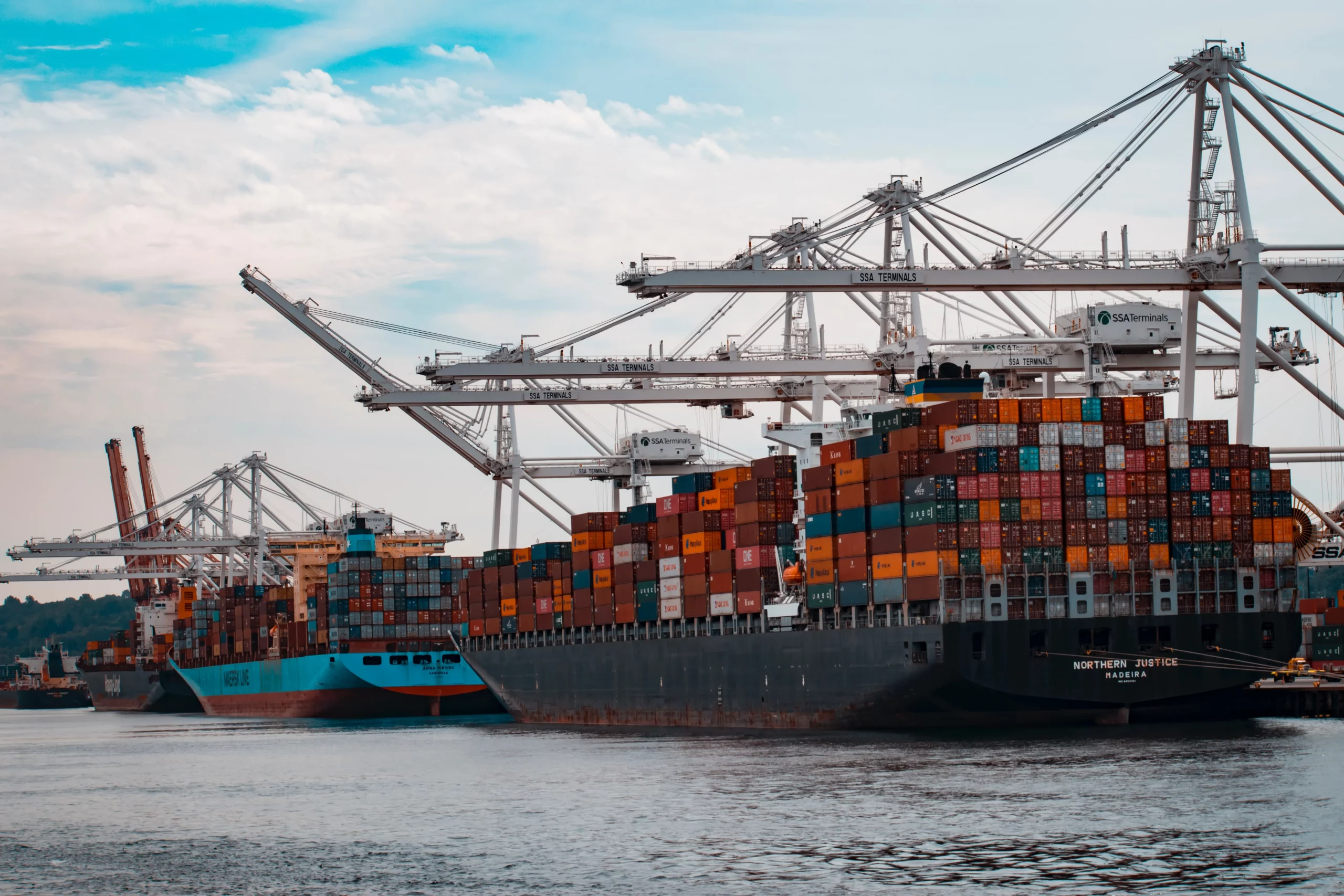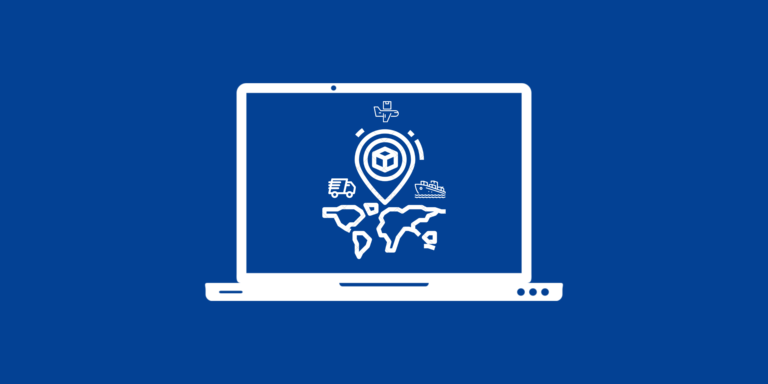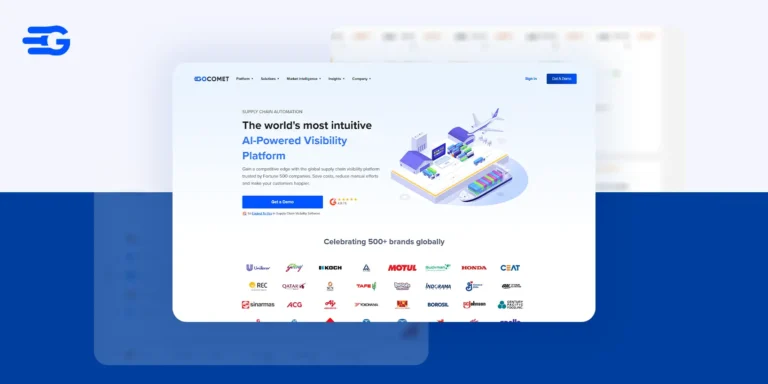Top 12 Ocean Freight Software of 2025
Managing ocean freight operations is no easy task. With the growing demands of global trade, businesses need more than just manual processes and spreadsheets. The right ocean freight software can be a game-changer, reducing errors, enhancing efficiency, and providing real-time data for smarter decision-making.
In this blog, we’ll look at the top 12 ocean freight software solutions of 2025, discussing their key features, limitations, and user experiences. Whether you are a small business or a large enterprise, there is a solution that will match your needs.
Criteria to Select the Right Ocean Freight Software?
Choosing the right ocean freight software can be a daunting task, but it’s crucial to find the best fit for your business needs. Here’s how to approach it:
- Evaluate Your Needs: Start by understanding your specific requirements. Do you need real-time tracking? Are you looking to optimize freight costs? Consider what features matter most for your business operations and select software that supports those needs.
- Ease of Use: Choose a solution that is user-friendly. The best software should require minimal training and have an intuitive interface that allows your team to start using it right away.
- Integration Capabilities: Ensure the software can integrate with your existing systems, such as ERP, CRM, and TMS. This will eliminate the need for duplicate data entry and ensure seamless communication between all parties in the supply chain.
- Customizability: Every business has unique requirements. Look for software that can be customized to fit your operations, whether it’s through reporting features, dashboard configurations, or the ability to add specific functionalities.
- Real-Time Tracking & Visibility: Transparency is key in ocean freight management. Opt for a solution that offers real-time tracking so you can stay updated on your shipments’ status and anticipate potential delays.
- Support and Customer Service: Evaluate the customer support provided by the software provider. Good customer service ensures that you have quick access to assistance when issues arise, reducing downtime and disruption to your operations.
- Scalability: As your business grows, your software should be able to scale with you. Look for a solution that can handle increasing shipping volumes and support your expanding network of suppliers and customers.
Top Ocean Freight Software – Comparison
| Software | Best For | Pros | Cons |
| GoComet | Freight procurement, shipment tracking, global visibility | – Global coverage (400+ carriers) – Real-time tracking – Port congestion data and insights | – Limited integration with small shipping carriers. |
| FreightPOP | Rate comparison, real-time tracking, analytics | – Cloud-based and scalable – Advanced analytics – Single platform for all shipping needs | – Interface can be overwhelming for new users – Limited global carrier network |
| Magaya | Inventory management, automated documentation | – Easy-to-use interface – Customizable reporting – Strong focus on inventory management | – Best suited for small-to-medium businesses – Limited integration with some carriers |
| ShipStation | E-commerce shipping and order management | – Easy integration with multiple sales channels – Automated shipping rules – User-friendly | – Focuses more on small to medium businesses – Limited features for larger global logistics |
| Freightos | Freight booking, carrier management, shipment visibility | – Real-time freight quotes – Customizable dashboard – Integrated with freight forwarders and carriers | – Not as robust for large-scale operations – Limited support for some specialized shipping needs |
| Kuebix | Rate comparison, carrier selection, logistics optimization | – Advanced analytics – Customizable dashboard – Integrates with multiple carriers | – Some features may require training – Best for medium to large businesses |
| LogistaaS | Freight forwarding, CRM and quotation management | – Automates documentation – Real-time shipment tracking – Intuitive interface | – Limited to freight forwarders – May not integrate well with other business tools |
| CargoWise | Multi-modal logistics, customs clearance, and global trade | – Handles complex multi-modal supply chains – Strong focus on customs clearance – Extensive carrier network | – Complex interface for first-time users |
| Flexport | End-to-end freight forwarding, real-time shipment visibility | – Intuitive interface – Real-time tracking and updates – Automated customs clearance | – Limited to global freight forwarding with some limitations in smaller regions |
| 3Gtms | Freight shipping management, rate comparison, and carrier selection | – Customizable dashboard – Real-time tracking – Integrates with multiple carriers | – Features might be too complex for small businesses – Best for medium to large-scale operations |
| Zencargo | Freight management, global logistics optimization | – Strong visibility – Customizable dashboards – Flexibility with carriers | – Limited global reach – |
| Transporeon | Freight procurement, data-driven decisions, carrier management | – Predictive analytics – Seamless collaboration – Global carrier network | – Steeper learning curve – Limited customization compared to competitors |
1. GoComet
GoComet is a leading provider of ocean freight software, offering a comprehensive suite of features designed to optimize supply chain operations. With its robust platform, GoComet helps businesses streamline their logistics, reduce costs, and enhance operational efficiency.
A standout feature is its real-time tracking capability, which provides continuous updates on shipments, ensuring that businesses stay informed and in control at every stage of the journey. By leveraging GoComet’s advanced technology, companies can improve decision-making, enhance visibility, and drive greater overall performance across their supply chain.
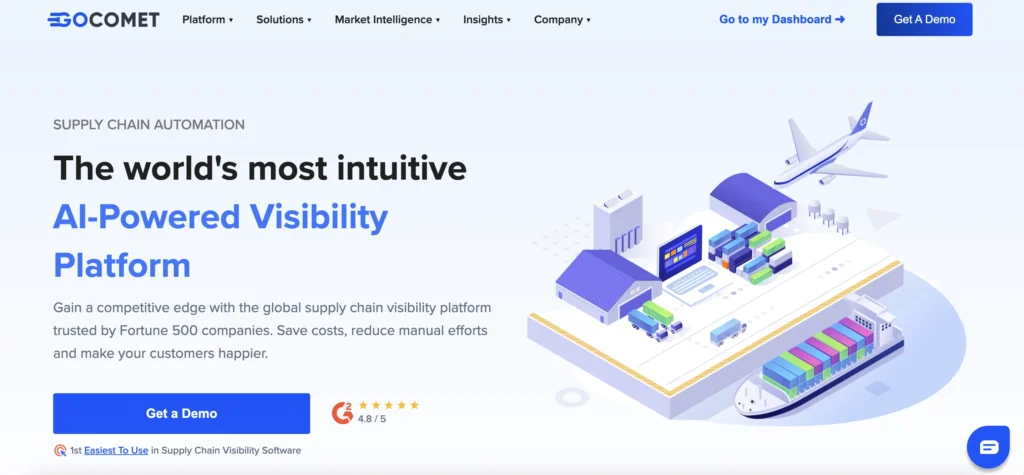
Key Features:
- Comprehensive Shipment Management: Gain total control with end-to-end tracking and management of shipments, from booking to delivery, ensuring seamless logistics operations.
- Effortless Freight Procurement: Streamline your logistics with automated carrier selection and booking, reducing manual workload and enhancing efficiency.
- Live Global Tracking: Access real-time updates on shipments across international routes, empowering faster decisions and proactive issue management.
- Proactive Port Congestion Alerts: Leverage detailed port congestion forecasts to mitigate disruptions and optimize your shipping schedules for uninterrupted delivery.
Limitations:
- Opportunity for Enhanced Road Tracking: While GoComet excels in features for import-export shipments, road tracking capabilities could be further refined.
Ratings:
G2 Rating: 4.8/5
Gartner Rating: 4.9/5
Testimonials:
“GoComet has transformed how we handle ocean freight. The real-time tracking and easy booking have saved us countless hours. Their port congestion data has been a lifesaver.”
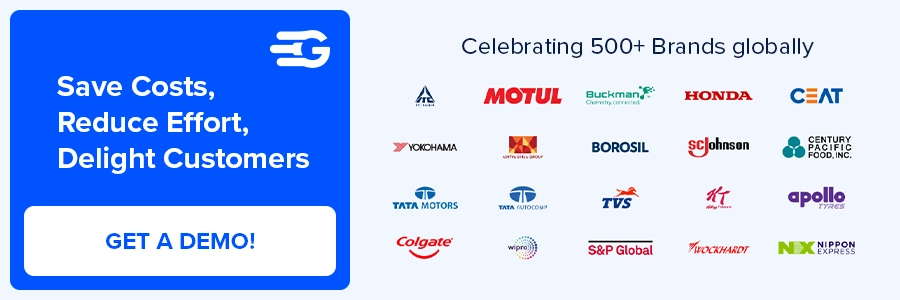
2. FreightPOP
FreightPOP is a versatile, cloud-based shipping software designed to streamline logistics operations for businesses of all sizes. With support for a wide range of carriers, FreightPOP allows companies to easily compare shipping rates, choose the most cost-effective options, and track shipments in real-time for enhanced visibility.
The platform also provides powerful analytics tools that enable businesses to assess and optimize shipping performance, identify cost-saving opportunities, and improve overall efficiency. Whether you’re managing multiple carriers or optimizing routes, FreightPOP empowers businesses to make smarter, data-driven shipping decisions and drive better outcomes across their supply chain.
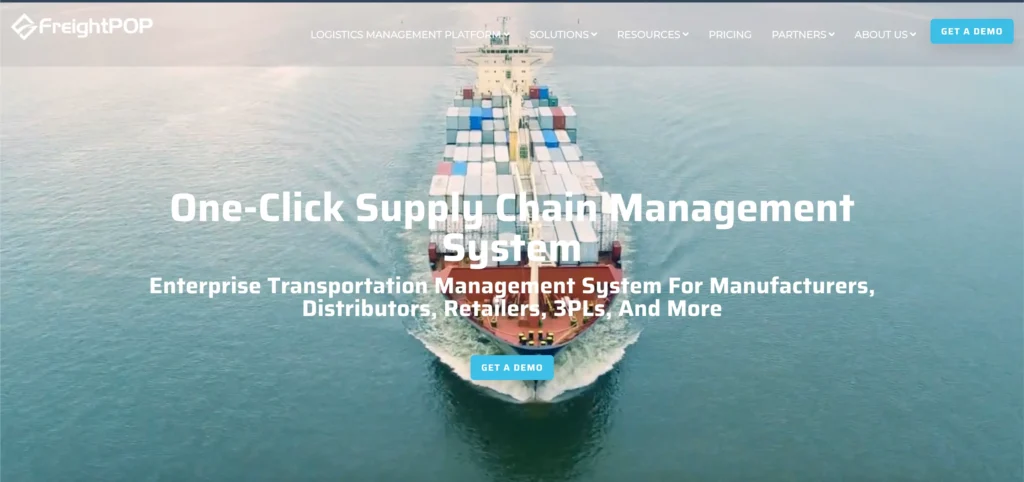
Key Features:
- Shipping Mode Flexibility: Supports LTL, FTL, Parcel, Ocean, Rail, and Air shipping, making it easy to manage various shipment types.
- Real-Time Tracking: Offers global shipment tracking with live updates for enhanced visibility and control.
- Predictive Analytics & Shipping Insights: Powered by Microsoft Power BI, providing valuable insights into shipping metrics, lowest quote tracking, and carrier performance.
- Automated Billing & Error Detection: Automatically identifies billing mistakes and enables centralized carrier payments.
Limitations:
- User Interface Needs Improvement: The graphical user interface (GUI) is simple to use but could be more polished and visually appealing for a better user experience.
- Limited Integration: Lacks an interface with certain software like Epicor Kinetics, which could limit integration options for some users.
Ratings:
G2 Rating: 4.8/5
Gartner Rating: NA
Testimonials:
“It allows us to pull everything into one place and capture everything so we can better understand our business. The entire team works with you to guide each user with help and support easy to access and chat with right when anything happens. Like all software there are a few hang ups here and there, but the support team is fast to help you resolve it.”
3. Magaya
Magaya is a versatile logistics management platform that goes beyond ocean freight. It offers a complete solution for managing inventory, shipments, payments, and more. It’s especially useful for companies in industries like manufacturing, where supply chain management extends beyond just shipping.
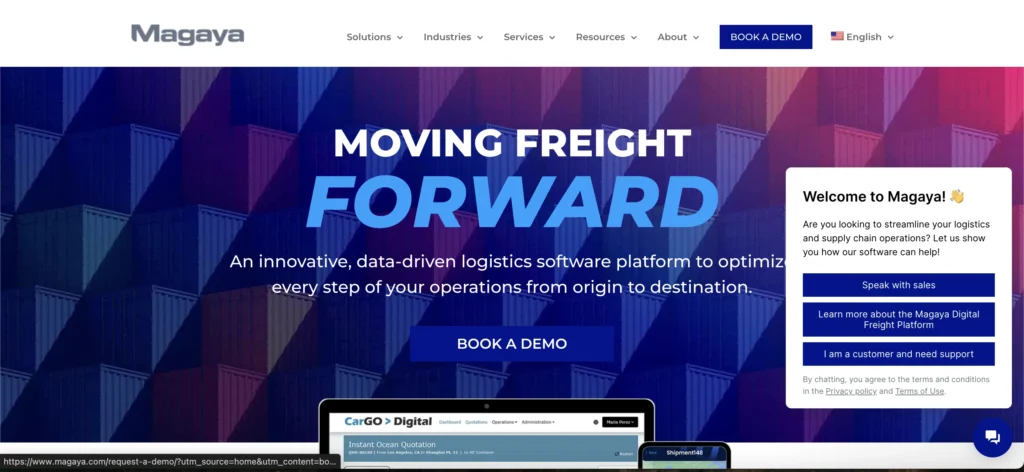
Key Features:
- Automated Documentation: Automatically generates and manages all necessary shipping documents, ensuring accuracy and compliance while reducing the chance of errors.
- Real-Time Tracking: Offers continuous updates on the status and location of shipments, keeping you informed at every step to ensure timely delivery.
- Inventory and Shipment Management: Streamlines the movement of goods from purchase orders to final delivery, including customs clearance, to ensure efficient and accurate supply chain operations.
Limitations:
- Installation Requirements: The software requires communication software to be installed on computers, which may need network administrators’ involvement, particularly for security-conscious networks.
- Complexity and System Crashes: Despite its many features, the platform can be complex, leading to occasional system crashes that disrupt workflows and affect productivity.
Ratings:
G2 Rating: 4.4/5
Gartner Rating: NA
Testimonials:
“I’m still getting fully acquainted with Magaya, but I think having ready-made dashboards would be a great enhancement. It would definitely add value by providing quick insights and making the data analysis even more accessible and efficient.”
4. ShipStation
ShipStation is best known for e-commerce shipping, but it also supports ocean freight. It’s ideal for businesses that manage both domestic and international shipping. The platform integrates with major carriers, allowing businesses to streamline their entire shipping process from one platform.
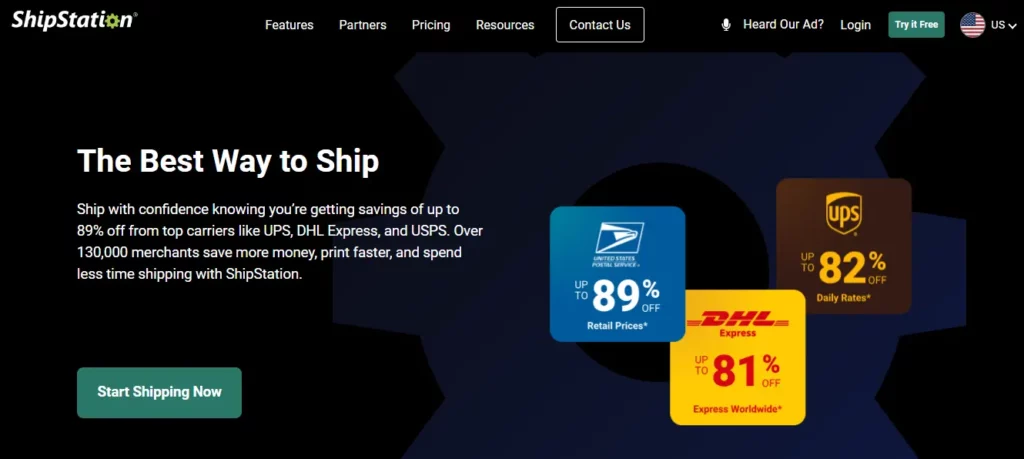
Key Features:
- Discounted Carrier Rates: Access pre-negotiated shipping rates from top carriers to automatically reduce your shipping costs on each order.
- Seamless Integration: Easily connect ShipStation with your e-commerce platforms and marketplaces to manage all your orders in one place.
- Automatic Cost Optimization: ShipStation automatically selects the most cost-effective carrier and service for each shipment, ensuring you always save.
- Support for Multiple Carriers: Ship with over 40 different carriers, giving you flexibility and the ability to choose the best option for your needs.
Limitations:
- Poor Customer Support: Users report inconsistent and unhelpful customer support, with a shift from human support to automated bots, making it difficult to resolve more complex issues.
- No Option to Delete Unused Return Labels: Return labels that are never used cannot be deleted, leading to clutter and inefficiency in the system.
Ratings:
G2 Rating: 4.3/5
Gartner Rating: NA
Testimonials:
“It’s the only app out there that lets me process shipments from woocommerce the way I need with return labels (rentals). Everything else. It’s a truly terrible system in every way possible. The very worst part is it takes me 30-40 clicks EVERY SINGLE TIME I want to log in. Which is daily.“
5. Freightos
Freightos is a cloud-based platform that connects shippers with freight forwarders and carriers. It simplifies the booking process, offers rate comparisons, and automates document management. It’s a great option for businesses that want to handle international shipping without hassle.
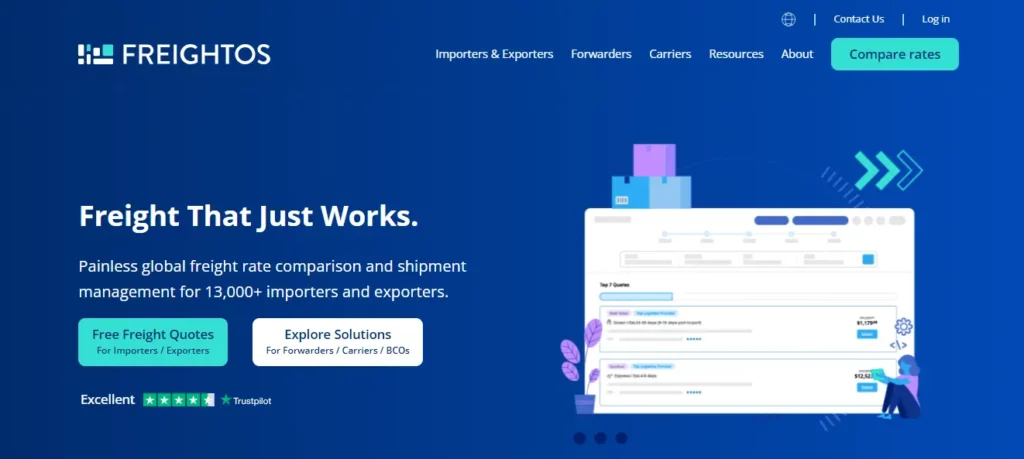
Key Features:
- Freight Quote Comparison: Compare air, ocean, and trucking freight quotes from multiple providers to find the best price and transit time options.
- Real-Time Shipment Tracking: Track shipments in real-time with milestone updates and proactive issue resolution.
- Booking, Tracking, and Communication: Streamline booking, tracking, and communication across logistics providers for better coordination.
- Route and Cost Optimization: Use real-time market intelligence to optimize shipping routes and costs.
Limitations:
- Cost Overruns: Freightos has been criticized for significant discrepancies between initial quotes and final costs, with some users reporting much higher-than-expected charges for shipments.
Ratings:
G2 Rating: 3.8/5
Gartner Rating: NA
Testimonials:
“Used to hold Freightos in high regard, but their recent performance has been nothing short of a disaster.“
6. Kuebix
Kuebix provides an advanced transportation management system (TMS) designed to optimize freight shipping for businesses of all sizes. With its powerful data-driven insights, Kuebix helps large enterprises streamline shipping processes, enhance operational efficiency, and reduce costs by offering detailed tracking and analytics at every step of the supply chain.
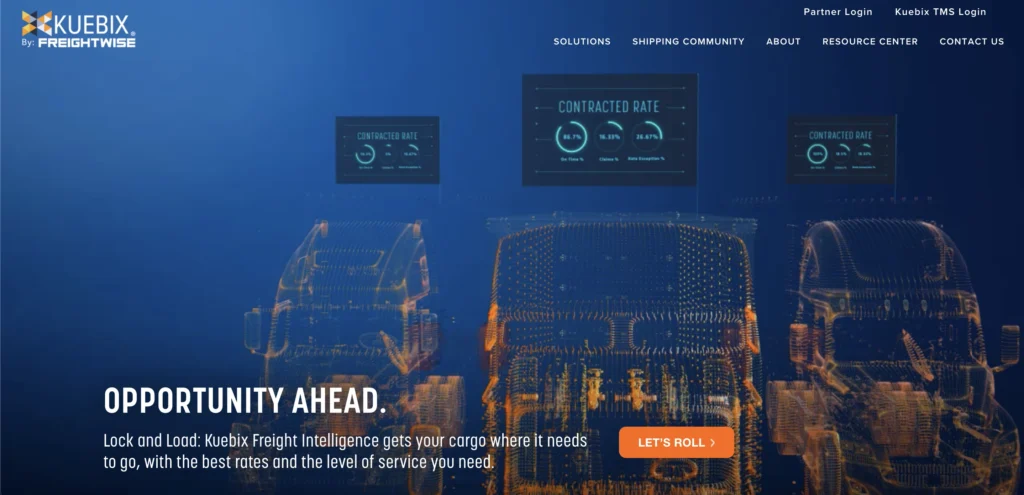
Key Features:
- Comprehensive Freight Visibility: Track every step of your freight’s journey, from order creation to the final mile, with full visibility into costs at the SKU level across all shipping modes.
- Cloud-Based Scalability: Leverage Kuebix’s secure, cloud-based TMS for seamless integration with internal and third-party systems, providing real-time updates and actionable insights for increased efficiency.
- Rapid Onboarding and Scalability: Quickly implement Kuebix with minimal disruption. Its modular design allows easy scaling as your business grows, supporting all carriers and shipping modes.
Limitations:
- Occasional Feature Bugs: Some users report that certain features, especially analytics, can be buggy at times, affecting the overall experience.
- Limited Rate Quote History: Unlike some competitors, Kuebix lacks comprehensive rate quote history reports, which makes it harder to review past rate data for better decision-making.
Ratings:
G2 Rating: NA
Gartner Rating: 4.6/5
Testimonials:
“Easy rate quote layout but lack of rate quote history reports that other TMS platforms offer. Also had conflicting pick up requests sent.“
7. LogistaaS
LogistaaS is a freight forwarding software that simplifies the management of shipments, especially for businesses involved in global trade. Its easy-to-use interface and automation tools help businesses save time and reduce the risk of errors.
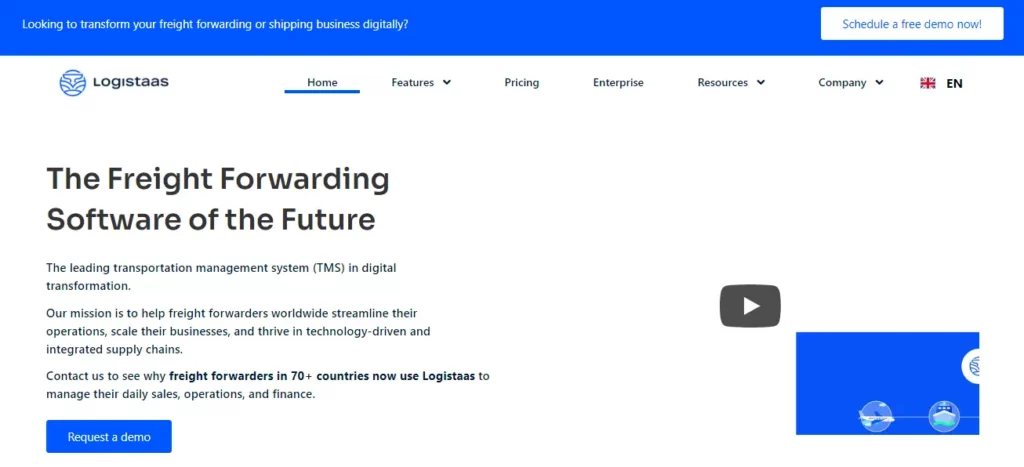
Key Features:
- Freight Quote Comparison: Allows comparison of freight quotes for air, ocean, and trucking from multiple providers to identify the best price and transit time options.
- Real-Time Shipment Tracking: Provides real-time shipment tracking with milestone updates and proactive issue resolution.
- Logistics Management: Facilitates booking, tracking, and communication across various logistics providers for streamlined operations.
- Route and Cost Optimization: Enables users to optimize shipping routes and costs using real-time market intelligence and access to benchmark freight rates for accurate market pricing.
Limitations:
- Integration Challenges: Integrating with existing systems can be difficult, requiring additional effort for smooth compatibility.
- Customer Support: While functional, customer support could be improved to provide more timely and effective assistance.
Ratings:
G2 Rating: 4.8/5
Gartner Rating: 4.9/5
Testimonials:
“Easy to use with user-friendly interface. Better accessibility with effective search tools and robust functionality. Integration with existing systems is challenging. Customer support can be better.”
8. CargoWise
CargoWise is a global logistics software platform designed for freight forwarders, customs brokers, and logistics service providers. It offers a wide range of tools that cover nearly every aspect of the supply chain, from freight forwarding to warehousing and customs clearance.
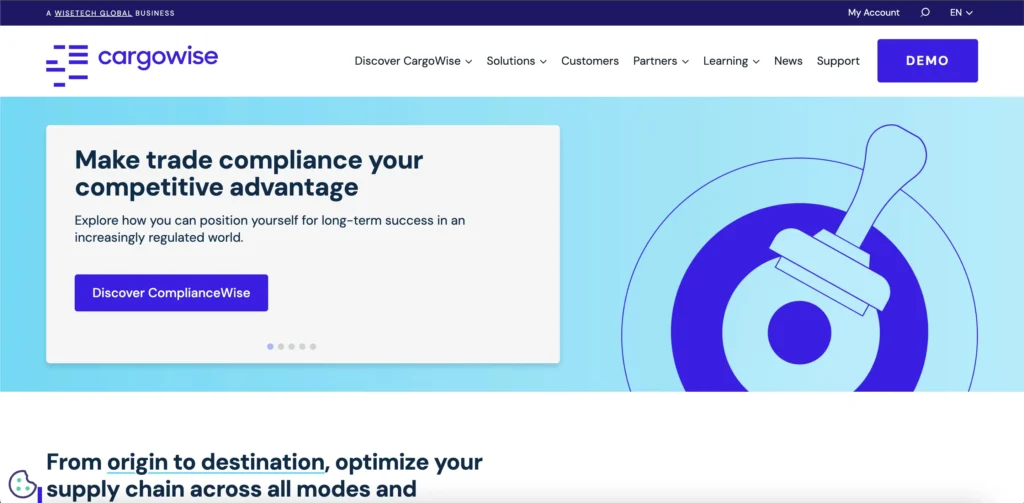
Key Features:
- Global Logistics Management: Streamline multi-modal transportation and manage international shipments, ensuring smooth operations across borders.
- Freight Forwarding Tools: Easily book shipments, manage rates, and track cargo progress, all in one place for efficient freight forwarding.
- Customs Compliance: Automate the customs clearance process to ensure shipments meet international regulations and avoid delays.
Limitations:
- Scalability Issues: While the software offers many well-developed features, it may not perform optimally at a large scale, making it less suitable for very large installations or enterprises with complex needs.
Testimonials:
“Software has many features well developed to support logistics business. I has some limitations running in big scale and the impression is that it is not going right direction for big scale installations.”
9. Flexport
Flexport is a modern freight forwarder that uses technology to streamline the entire shipping process. It provides end-to-end visibility, automates compliance, and offers detailed analytics to help businesses optimize their supply chains.
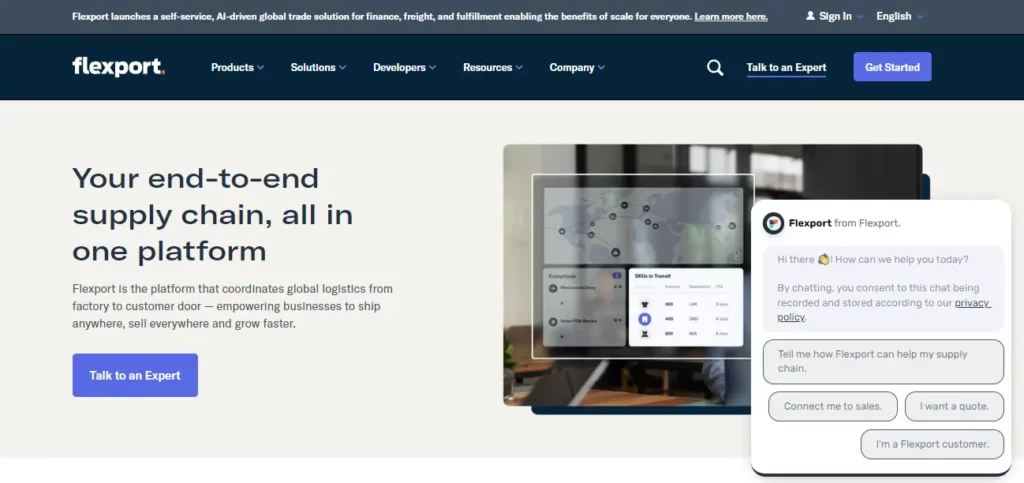
Key Features:
- Real-Time Shipment Visibility: Track all shipments in one place with detailed updates on their status.
- Automated Customs Compliance: Automates the customs compliance process to prevent delays and ensure smooth shipments.
- Data-Driven Insights: Provides detailed performance analytics to support better decision-making and operational improvements.
Limitations:
- Customer Service Issues: Flexport’s customer service is often criticized for being slow and unhelpful, leading to frustration.
Ratings:
G2 Rating: 4.8/5
Gartner Rating: 4.9/5
Testimonials:
“What I liked the best about Flexport is the way their interface helps you to use their services. What I dislike the most about Flexport is their customer service.“
10. 3Gtms
3Gtms is a transportation management system (TMS) that helps companies manage freight shipping across all transportation modes. It offers powerful tools for rate comparison, carrier selection, and real-time tracking, all within an easy-to-use interface.
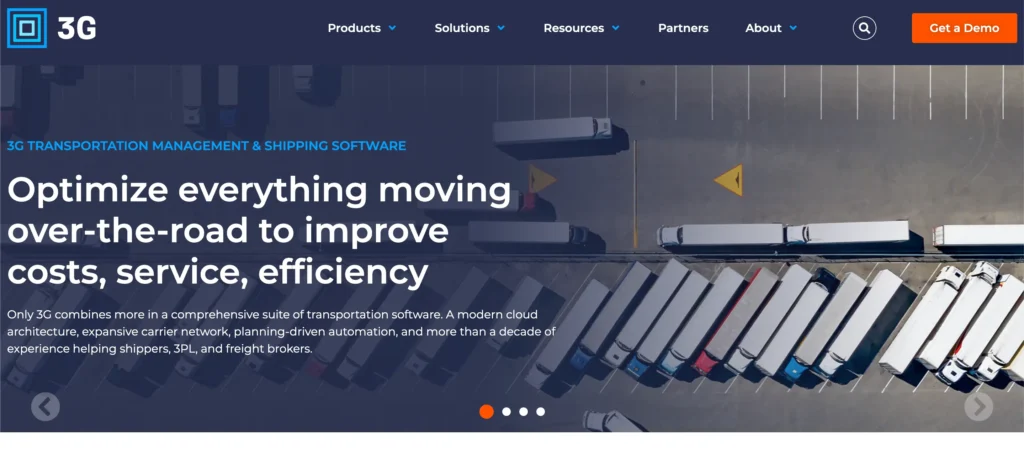
Key Features:
- Use Real-Time Tracking: Monitor shipments from start to end for better operational control and faster issue resolution.
- Reduce Costs Through Optimization: Automate route planning and carrier selection to minimize shipping expenses.
- Eliminate Manual Work: Leverage automated tools for tasks like load planning and freight auditing to save time and improve accuracy.
- Integrate Easily: Connect the system with platforms like QuickBooks and Truckstop.com to centralize your data and workflows effortlessly.
Limitations:
- Challenging Implementation: The software requires a significant amount of time for setup and training, making the onboarding process lengthy and resource-intensive.
- Complex User Interface: Business Intelligence (BI) tools and routing maps are difficult to use and lack intuitive dashboards, making them less accessible for new users.
Ratings:
G2 Rating: 3.9/5
Gartner Rating: 4.5/5
Testimonials:
“Excellent technology. changes and updates are getting difficult to update the system as the platforms grows. however it has been delivering great results for our organization”
11. Zencargo
Zencargo is a cutting-edge freight management platform designed to help businesses streamline their logistics and supply chain operations. This software provides a digital solution for managing ocean freight, from booking shipments to tracking and optimizing costs. Zencargo’s intuitive interface allows businesses to gain end-to-end visibility, reduce manual processes, and improve the decision-making process.
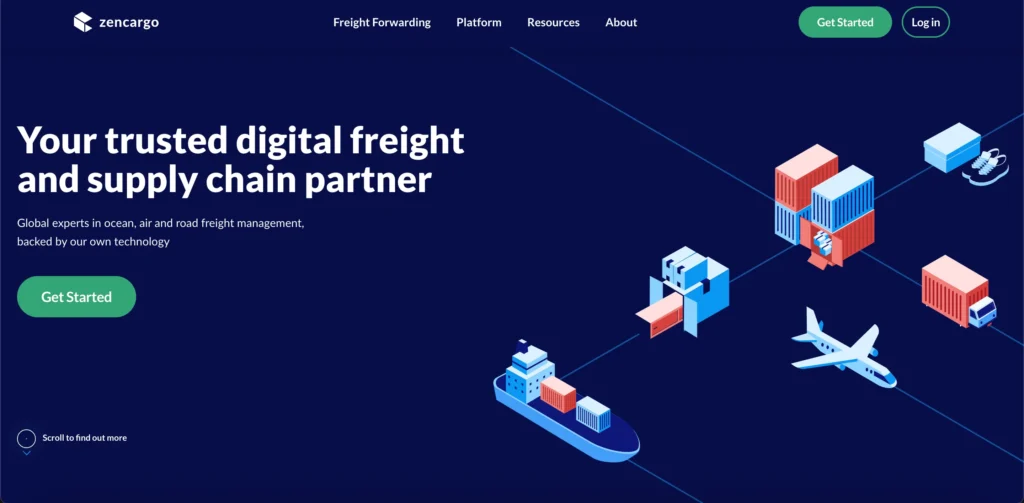
Key Features:
- Streamline Inventory Management: Leverage forecasting and agile tools to maintain stock availability while minimizing overstock and freeing up working capital.
- Enhance Collaboration and Resilience: Utilize a robust digital platform to improve visibility, foster teamwork, and adapt to changing market demands.
- Drive Sustainability Efforts: Track, reduce, and offset supply chain emissions with accredited data to meet environmental goals.
- Boost Revenue and Service: Avoid stockouts, prioritize key products, and maintain brand reputation with adaptive solutions that fulfill customer expectations.
Limitations:
- Limited Global Reach: While Zencargo is rapidly expanding, it may not yet support as many global carriers as other industry leaders.
Ratings:
G2 Rating: 5/5 (based on one review!)
Gartner Rating: NA
Testimonial:
“It helped us to prioritise and deliver the right products at the right time to maximise customer service and full-price sales.”
12. Transporeon
Transporeon is an advanced platform offering cloud-based solutions for freight procurement, transportation management, and visibility across ocean, air, and land freight. It’s designed to help companies optimize their shipping processes and reduce costs while improving overall efficiency. Transporeon’s solutions are particularly beneficial for companies looking for a more data-driven approach to ocean freight management.
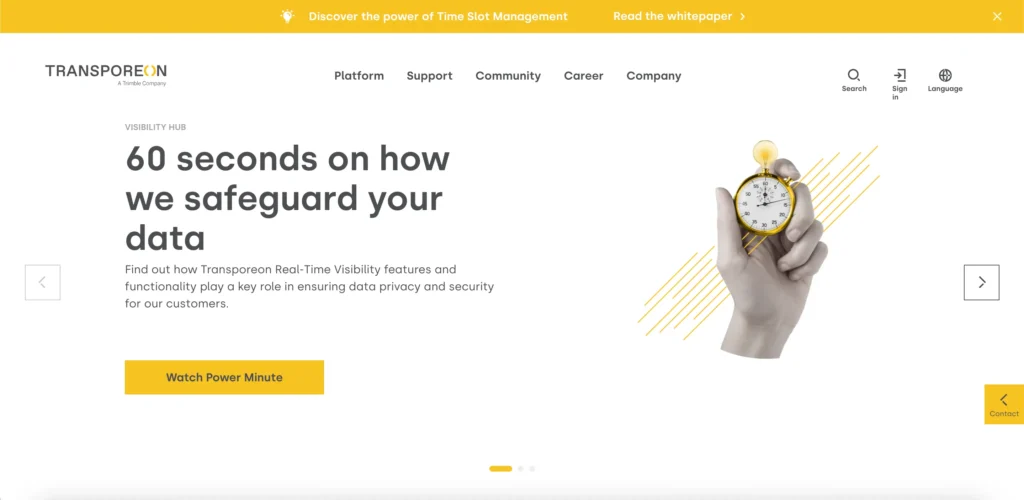
Key Features:
- Freight Procurement: Automates the procurement process by connecting shippers with a global network of carriers, allowing for more competitive pricing.
- Real-Time Visibility: Provides real-time updates on the status of ocean shipments, allowing businesses to track their goods with precision.
- Data-Driven Decisions: Utilizes predictive analytics to identify opportunities for cost savings and improve operational efficiency.
- Collaborative Platform: Allows for seamless communication between shippers, carriers, and logistics providers, enhancing collaboration and transparency.
Limitations:
- Learning Curve: Due to its wide range of features, some users may experience a steeper learning curve.
- Customization: While the platform is highly feature-rich, customization options are limited compared to other solutions.
Ratings:
G2 Rating: 4.1/5
Gartner Rating: 3.6/5
Testimonial:
“Average experience, on the one hand and easy to use platform, simple to edit, on the other hand annoying limititations and gaps.“
Final Thoughts
Choosing the right ocean freight software is critical to enhancing your supply chain operations. The solutions highlighted here are leaders in the industry, offering everything from real-time tracking to automated documentation and advanced analytics. By selecting the software that best fits your needs, you can streamline your processes, reduce costs, and improve efficiency. Whether you need a simple, easy-to-use platform or a comprehensive system for managing complex logistics, there’s a tool out there that can elevate your shipping operations.
Feel free to reach out to us if you are looking for accurate, reliable and easy-to-use ocean freight software.
FAQs
Can ocean freight software integrate with other systems?
Yes, many ocean freight software solutions offer integration capabilities with existing systems such as ERP, TMS, or CRM. This enables seamless data flow, minimizes manual data entry, and enhances overall efficiency in managing shipping operations.
How secure is ocean freight software in terms of data protection?
Ocean freight software providers prioritize data security and employ measures such as data encryption, secure servers, regular backups, and compliance with industry standards to protect sensitive shipping information.
Are updates for ocean freight software in real-time?
The availability of real-time updates in ocean freight software varies depending on the provider and data synchronization with carriers, but some software solutions do offer real-time updates on shipment status and location.
